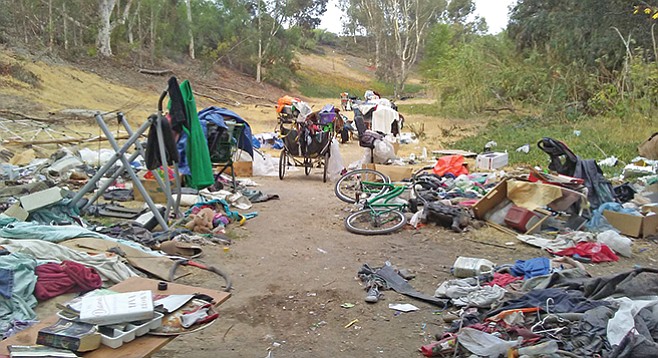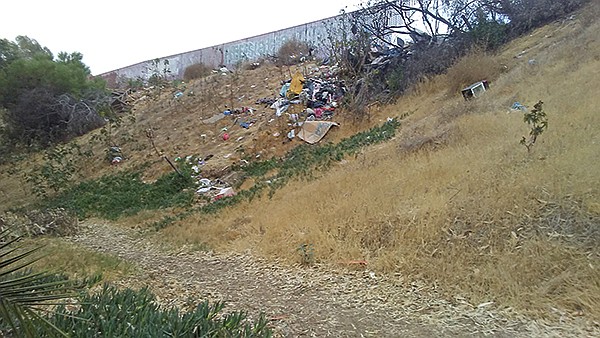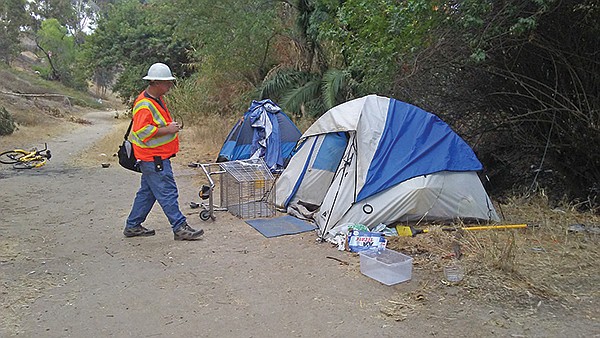 Facebook
Facebook
 X
X
 Instagram
Instagram
 TikTok
TikTok
 Youtube
Youtube

The numbers are alarming: 30 percent of Caltrans’ $18.1 million local maintenance budget went for picking up after people last year. $6.2 million went toward picking up litter off the freeway and for cleaning out the debris fields left behind by homeless encampments abandoned in the wake of 72-hour notices that trash crews are coming.

“That’s the stuff they didn’t want,” said Caltrans spokesman Ed Joyce. “Last year, taxpayers spent millions for crews to work nearly 56,500 hours cleaning up after other people.”

Last year, in San Diego and Imperial counties, Caltrans hauled an amount that would take more than 10,000 large dump trucks to move. Lined up, that’s more than 30 miles of dump trucks loaded with trash.
It’s the single largest maintenance expenditure; tree maintenance is next at $4.8 million, with bridge and guardrail inspections and repairs at around $2.9 million.
Costs continue to rise; but trash clean-up continues even after the annual budget is spent. It’s a matter of public safety, says spokesman Ed Joyce.
Or as the maintenance chief says, “Without the heavy equipment, we’d basically be a maid service.”
The freeway tidy-ups yield a crop of bizarre stuff: Tires are the No.1 find, mattresses come close behind at 50 per month. Ladders, furniture and all kinds of landscaping tools and materials. “We keep telling people to tie down their loads before they get on the freeway,” says Everett Townsend, Caltrans district division chief of maintenance.
Homeless encampments have spiked in the past four or five years, Townsend says, and Caltrans customer service line gets dozens of calls each week from citizens reporting them. The city’s strategies pushed some of the homeless out of downtown and into the neighborhoods, and police efforts there have pushed the people to find places to camp where they are less visible.
The Caltrans costs for these clean-ups aren’t usually included in the city’s and region’s assessment of the effects of homelessness, officials say.
“I’ve seen staircases dug into hillsides and full-on showers where the water comes from (landscape) irrigation piping,” says California Highway Patrol officer Jake Sanchez. “They definitely have skill sets where they shouldn’t have to be homeless.”
Sanchez says there are chronic camps off I-8 at Taylor Street and off I-5 at Imperial Avenue.
There are recurring camps along Highway 94, including those just east of the end of the 94 and east of the I-5 south onramps. Fires started by homeless people have disrupted freeway traffic around a particularly persistent and gnarly site next to the 94 at College Avenue. Another site, west side of the 805 at the Adams Avenue exit just came to their attention again. Anywhere you see a Caltrans fence cut big enough for a person to go through, there’s probably a camp there.
But homeless people have gotten in to Caltrans property where you wouldn’t expect to see them.
“They break into our facilities and get into our bridge cells. We find people who live in culverts and we’ve had to put grates on,” Townsend says. “We have to make sure we aren’t compromising the drainage system and causing flooding somewhere else.”
From the fence line between the Willie Henderson Sports Complex park and the Caltrans right-of-way on the southbound side of the 805, a larger than usual camp has been dug deep into the canyon near the 43rd Street off-ramp. It’s well-hidden by the topography — a steep-sided and narrow canyon with the 805 on the east and the park on the west. And it’s bigger than most sites.
On a fine August morning that I accompany a crew, the CHP officer escorting the clean-up crew finds and holds open a hole in the fence while we clamber through and then scramble down a steep path used so much that the stairs cut into the dirt have rounded at the edge and slope downward.
At the bottom of the canyon, we see two tents pitched a few feet apart, the round ones that look like domes, and there’s trash, enough that it looks like the floor of a stadium after a rowdy game. That trash barely registers with the Caltrans advance team. One of the two CHP officers escorting us stops to speak respectfully into the tents but no one answers. We walk through a narrowing curve that opens onto a wider area of the canyon floor, and find the largest trash mess I’ve ever seen. In its midst: lined off ‘rooms’ marked with drapes and poles and covered with tarps. One has a DIY clothes rack with plastic hangers, all empty. There’s a gas grill — one of the silver-colored metal ones — has been hacked to burn charcoal and the smoky smell of last night’s food lingers on the coals.
There are yellow and green dockless bikes scattered around in varying states of disassembly. There are folding camp stools and woven web chairs, makeshift rooms and broken chairs around a fire pit.
Some of the trash makes sense, like the grill. Much of it doesn’t, as if it’s a debris field from two planes full of household items that crashed into each other, minus the plane parts. It spreads more than a hundred feet south and 70 or 80 feet wide, narrowing with the contours of the canyon. Trash climbs up the sides of the canyon and lays stinking in the dry creek bed.
“There are so many items,” said Ed Joyce with Caltrans. “Typically there’s soiled clothing and bedding, bicycle parts, trash, televisions, generators, car batteries, old mattresses, rotten food, broken cell phones, radios, shelving, old medical devices, stoves, refrigerators ... even prosthetic limbs and wheel chairs.”
“One of our maintenance workers told me it’s like going to a swap meet and the landfill all at once,” added Joyce.
Despite the freeway up the hill, it’s quiet — the CHP officers who escorted us can be heard talking with people they found behind and within a stand of bamboo as big as a small house.
Joyce points out a couple of strange places that don’t immediately register as beds. One looks like a giant pile of bamboo and palm leaves with a seven-foot diameter cap on it, but then I see an oval hole at the front big enough to crawl into. He tells me Caltrans crews have found bamboo stands riddled with the wide, low ovals that people can crawl into and they find rooms at the end of these tunnels carved inside the stand.
This site will take about two days to clean up and crews have a front end loader and the first dump truck on the way, says Caltrans spokesman Joyce.
A crew of about 20 workers in orange vests and hardhats, hired through a contractor, arrive and begin moving trash to areas where the front-end loader can go — because the loader can’t go into the brush or the old creek bed, also full of trash.
“Caltrans will post a 72-hour notice ahead of time that crews are planning to clean up the area,” said Joyce. “Generally, people will take their possessions of value and leave, but as you can see, a lot of trash and debris is left behind.”
The number of homeless camps on Caltrans land amounts to an epidemic, CHP officers say. In El Cajon, the public information officer checked the office schedule — and echoed others’ statements that cleanups almost amount to “maid service” as well. He expects the campers to return within a week of the cleanup completion and has seen people waiting on the other side of the Caltrans chain link fence.
“We have four cleanups we’re going out on this week,” says CHP Officer Travis Garrow. “It’s not safe for them without law enforcement.”
Joyce said that crews regularly clean out encampments but generally find that people later return to the location. This one was cleared seven or eight months ago.
The crews clean out such camps in three or four locations a week, Joyce said. Interstate 5 has the worst messes, 805 is second, and south of the 8 requires more attention than north.
They get dozens of calls every week identifying new encampments, and they get to them as quickly as they can. But emergencies, like serious crashes and fires jumping state highways, are more important, and the crews get diverted to help with emergencies.
As we walk back to the path up the steep hill, we see that one of the two blue tents is gone. And minutes later we see two men carrying a large mattress up the hill and pushing it through another hole in the fence.
“If it’s on the other side of the fence, it’s not on Caltrans land, so we leave it,” Joyce says. He stares at the hole we’re climbing through to leave the cleanup site.
“We’ll also have to fix that fence,” he adds.


The numbers are alarming: 30 percent of Caltrans’ $18.1 million local maintenance budget went for picking up after people last year. $6.2 million went toward picking up litter off the freeway and for cleaning out the debris fields left behind by homeless encampments abandoned in the wake of 72-hour notices that trash crews are coming.

“That’s the stuff they didn’t want,” said Caltrans spokesman Ed Joyce. “Last year, taxpayers spent millions for crews to work nearly 56,500 hours cleaning up after other people.”

Last year, in San Diego and Imperial counties, Caltrans hauled an amount that would take more than 10,000 large dump trucks to move. Lined up, that’s more than 30 miles of dump trucks loaded with trash.
It’s the single largest maintenance expenditure; tree maintenance is next at $4.8 million, with bridge and guardrail inspections and repairs at around $2.9 million.
Costs continue to rise; but trash clean-up continues even after the annual budget is spent. It’s a matter of public safety, says spokesman Ed Joyce.
Or as the maintenance chief says, “Without the heavy equipment, we’d basically be a maid service.”
The freeway tidy-ups yield a crop of bizarre stuff: Tires are the No.1 find, mattresses come close behind at 50 per month. Ladders, furniture and all kinds of landscaping tools and materials. “We keep telling people to tie down their loads before they get on the freeway,” says Everett Townsend, Caltrans district division chief of maintenance.
Homeless encampments have spiked in the past four or five years, Townsend says, and Caltrans customer service line gets dozens of calls each week from citizens reporting them. The city’s strategies pushed some of the homeless out of downtown and into the neighborhoods, and police efforts there have pushed the people to find places to camp where they are less visible.
The Caltrans costs for these clean-ups aren’t usually included in the city’s and region’s assessment of the effects of homelessness, officials say.
“I’ve seen staircases dug into hillsides and full-on showers where the water comes from (landscape) irrigation piping,” says California Highway Patrol officer Jake Sanchez. “They definitely have skill sets where they shouldn’t have to be homeless.”
Sanchez says there are chronic camps off I-8 at Taylor Street and off I-5 at Imperial Avenue.
There are recurring camps along Highway 94, including those just east of the end of the 94 and east of the I-5 south onramps. Fires started by homeless people have disrupted freeway traffic around a particularly persistent and gnarly site next to the 94 at College Avenue. Another site, west side of the 805 at the Adams Avenue exit just came to their attention again. Anywhere you see a Caltrans fence cut big enough for a person to go through, there’s probably a camp there.
But homeless people have gotten in to Caltrans property where you wouldn’t expect to see them.
“They break into our facilities and get into our bridge cells. We find people who live in culverts and we’ve had to put grates on,” Townsend says. “We have to make sure we aren’t compromising the drainage system and causing flooding somewhere else.”
From the fence line between the Willie Henderson Sports Complex park and the Caltrans right-of-way on the southbound side of the 805, a larger than usual camp has been dug deep into the canyon near the 43rd Street off-ramp. It’s well-hidden by the topography — a steep-sided and narrow canyon with the 805 on the east and the park on the west. And it’s bigger than most sites.
On a fine August morning that I accompany a crew, the CHP officer escorting the clean-up crew finds and holds open a hole in the fence while we clamber through and then scramble down a steep path used so much that the stairs cut into the dirt have rounded at the edge and slope downward.
At the bottom of the canyon, we see two tents pitched a few feet apart, the round ones that look like domes, and there’s trash, enough that it looks like the floor of a stadium after a rowdy game. That trash barely registers with the Caltrans advance team. One of the two CHP officers escorting us stops to speak respectfully into the tents but no one answers. We walk through a narrowing curve that opens onto a wider area of the canyon floor, and find the largest trash mess I’ve ever seen. In its midst: lined off ‘rooms’ marked with drapes and poles and covered with tarps. One has a DIY clothes rack with plastic hangers, all empty. There’s a gas grill — one of the silver-colored metal ones — has been hacked to burn charcoal and the smoky smell of last night’s food lingers on the coals.
There are yellow and green dockless bikes scattered around in varying states of disassembly. There are folding camp stools and woven web chairs, makeshift rooms and broken chairs around a fire pit.
Some of the trash makes sense, like the grill. Much of it doesn’t, as if it’s a debris field from two planes full of household items that crashed into each other, minus the plane parts. It spreads more than a hundred feet south and 70 or 80 feet wide, narrowing with the contours of the canyon. Trash climbs up the sides of the canyon and lays stinking in the dry creek bed.
“There are so many items,” said Ed Joyce with Caltrans. “Typically there’s soiled clothing and bedding, bicycle parts, trash, televisions, generators, car batteries, old mattresses, rotten food, broken cell phones, radios, shelving, old medical devices, stoves, refrigerators ... even prosthetic limbs and wheel chairs.”
“One of our maintenance workers told me it’s like going to a swap meet and the landfill all at once,” added Joyce.
Despite the freeway up the hill, it’s quiet — the CHP officers who escorted us can be heard talking with people they found behind and within a stand of bamboo as big as a small house.
Joyce points out a couple of strange places that don’t immediately register as beds. One looks like a giant pile of bamboo and palm leaves with a seven-foot diameter cap on it, but then I see an oval hole at the front big enough to crawl into. He tells me Caltrans crews have found bamboo stands riddled with the wide, low ovals that people can crawl into and they find rooms at the end of these tunnels carved inside the stand.
This site will take about two days to clean up and crews have a front end loader and the first dump truck on the way, says Caltrans spokesman Joyce.
A crew of about 20 workers in orange vests and hardhats, hired through a contractor, arrive and begin moving trash to areas where the front-end loader can go — because the loader can’t go into the brush or the old creek bed, also full of trash.
“Caltrans will post a 72-hour notice ahead of time that crews are planning to clean up the area,” said Joyce. “Generally, people will take their possessions of value and leave, but as you can see, a lot of trash and debris is left behind.”
The number of homeless camps on Caltrans land amounts to an epidemic, CHP officers say. In El Cajon, the public information officer checked the office schedule — and echoed others’ statements that cleanups almost amount to “maid service” as well. He expects the campers to return within a week of the cleanup completion and has seen people waiting on the other side of the Caltrans chain link fence.
“We have four cleanups we’re going out on this week,” says CHP Officer Travis Garrow. “It’s not safe for them without law enforcement.”
Joyce said that crews regularly clean out encampments but generally find that people later return to the location. This one was cleared seven or eight months ago.
The crews clean out such camps in three or four locations a week, Joyce said. Interstate 5 has the worst messes, 805 is second, and south of the 8 requires more attention than north.
They get dozens of calls every week identifying new encampments, and they get to them as quickly as they can. But emergencies, like serious crashes and fires jumping state highways, are more important, and the crews get diverted to help with emergencies.
As we walk back to the path up the steep hill, we see that one of the two blue tents is gone. And minutes later we see two men carrying a large mattress up the hill and pushing it through another hole in the fence.
“If it’s on the other side of the fence, it’s not on Caltrans land, so we leave it,” Joyce says. He stares at the hole we’re climbing through to leave the cleanup site.
“We’ll also have to fix that fence,” he adds.
Comments